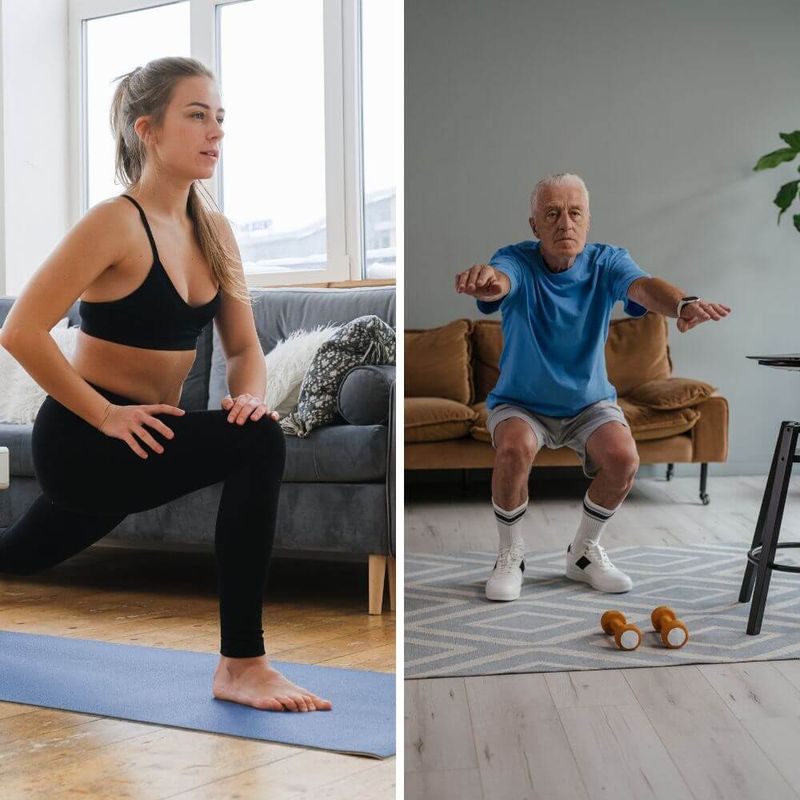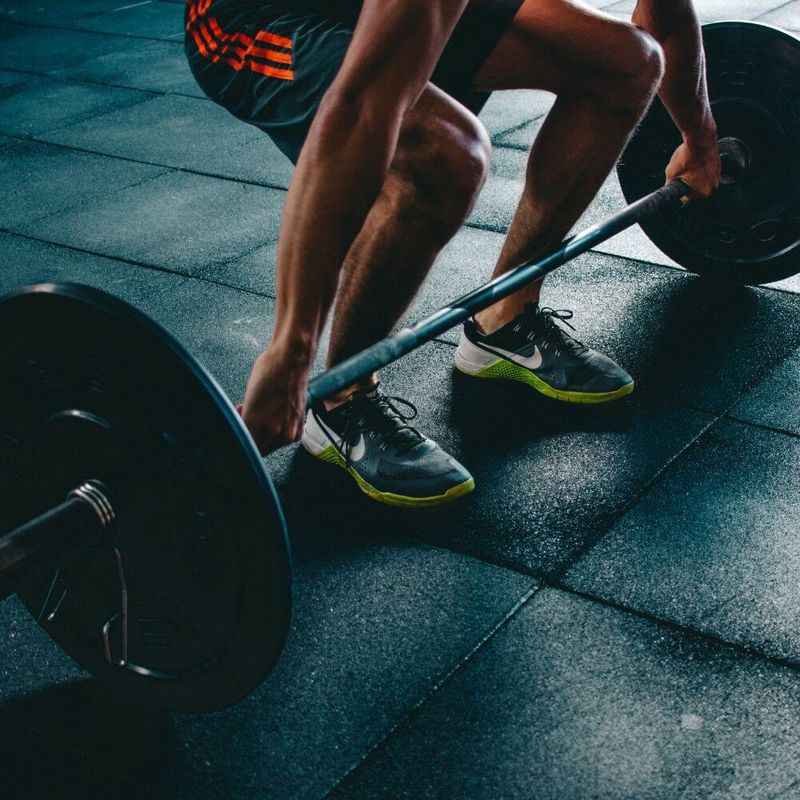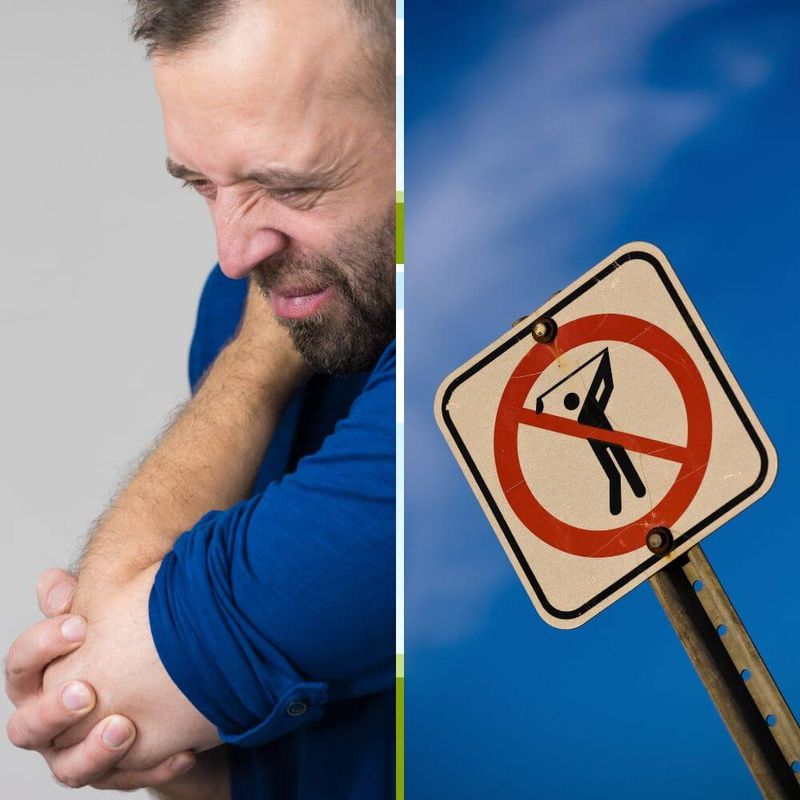Content Summary
Table of Contents
Brief overview of the importance of fitness in improving golf performance
Section 1: Lower Body Exercises
- Exercise 1: Split Squat
- Exercise 2: Side Lunges
- Exercise 3: Tempo Squats
- Exercise 4: Hamstring & Lower Back Stretch
Section 2: Core Strength Exercises
- Exercise 5: Pelvic Rotation
- Exercise 6: Deadbug
Section 3: Upper Body and Shoulder Exercises
- Exercise 7: Push-ups
- Exercise 8: Shoulder Internal & External Stretch
Section 4: Full Body and Mobility Exercises
- Exercise 9: Overhead Squats
- Exercise 10: Full Body Turn
- Exercise 11: Trunk Rotations
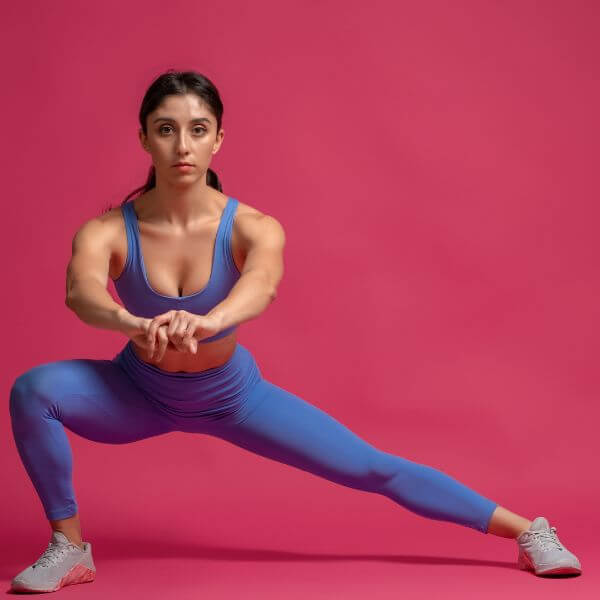
Overview of Golf Fitness Importance
Strength and Power: Golf requires strength and power, particularly in the core and the lower body.
A strong swing is one of the most important aspects of the game, and it's heavily dependent on your physical strength. By improving your strength through fitness, you can increase the power of your swing and potentially drive the ball further.
Flexibility and Mobility: Golf also requires a great deal of flexibility and mobility.
The golf swing involves a complex range of motion, and having good flexibility can help you perform this motion more effectively. This can improve your swing mechanics and reduce the risk of injury.
Endurance: Although golf might not seem like an endurance sport, walking the course and maintaining concentration for several hours requires a certain level of physical stamina.
Regular cardiovascular exercise can improve your endurance, helping you stay fresh and focused throughout the round.
Balance and Stability: The golf swing requires a significant amount of balance and stability. Fitness exercises that target these areas can help you maintain a stable base during your swing, which can improve your accuracy and consistency.
Injury Prevention: Regular fitness training can also help prevent injuries. By strengthening your muscles and improving your flexibility, you can reduce the risk of common golf injuries such as back pain or shoulder strain.
As golf enthusiasts we all can agree that training to improve our game is essential, but sometimes getting to the golf course or driving range can be a challenge.
And if you haven't done anything to improve your fitness, just hitting balls at the range isn't really going to help you progress as much as you would like.
Fortunately, you don't need to leave your house to work on your golf skills. With home golf drills and indoor golf training, you can practice and perfect your swing with ease. No special equipment required.
Let's take a look at some specific golf exercises at home you can do to help you swing better and make better contact with the golf ball.
Here are exercises suitable for golfers of all ages and fitness levels. I do most of the following exercises on a daily basis myself and have been doing so for many years.
Honestly, I don't know if I could continue to play golf without them. I also incorporate 4 mile walks 3-4 times a week as well for a consistent cardio workout. In addition I walk the course and do not use a cart.
Now, I'm not suggesting everyone should do what I do but I wanted to share my regimen with my readers to hopefully inspire you a bit.
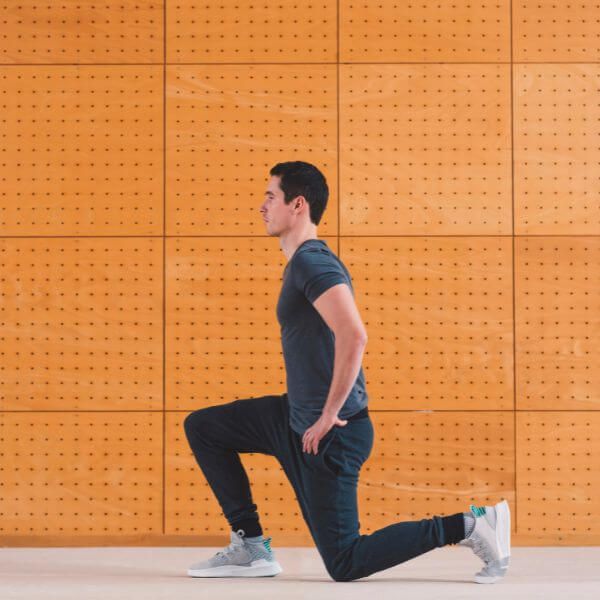
Lower Body Exercises
The first exercise we'll cover is the Split Squat. This exercise targets not only your lower body but also helps with balance and core strength.
To perform a split squat, start by standing with one foot forward and one foot back in a lunge position. Lower down until your back knee is just above the ground and then push back up through the front heel. Repeat for 12 reps on each leg.
Next are Side Lunges which are an effective way to strengthen your legs without weights. In this routine you want to focus on your tempo making sure that you are controlling the movement.
If you can do the movements slowly and under control you will feel like you get a much better workout since your muscles will be under more tension for a longer period of time.
Start with your legs spread apart at shoulder width, keep your upper body upright and your arms in front of your chest then lean (lunge) into your right leg then switch over to the left leg. Do 12 reps on each leg.
As the name implies with Tempo Squats the emphasis is on the tempo and making sure that you slowly move into the squat position and then pause for a couple of seconds at the bottom.
When you come up you want to still control the tempo to ensure you keep your legs under as much tension as possible.
One thing to make sure of is to not lock out your knees when you stand as well keeping a slight bend because that will help to keep the tension in your legs.
If you haven't done this exercise before I can tell you from personal experience that you will definitely feel a burn in your legs.
Hamstring & Lower Back Stretch
1. Seated Assisted Toe Touch exercise focuses on your hamstrings.
To perform it, sit on the ground with your feet slightly apart. Place a golf club across your feet and reach in the middle of your legs to grab hold of the driver shaft.
Gradually extend your legs and draw your upper body towards your feet. You should experience a stretch in your hamstrings and calves. Maintain this pose for 45 seconds.
Alternatively, you can execute this stretch in a standing position, reaching for your toes with the club, similar to the seated version.
2. Elevated Child Pose This is a great exercise for those with a stiff back. This is a golf mobility exercise designed to stretch your back and hip muscles, enhancing your rotation and power generation.
To start, stand the driver upright, place both hands on top of the grip, and position yourself three feet away from the club.
Gradually hinge at the hips, extending your arms forward as your head descends towards your biceps.
This pose is an excellent method to ease tension and relax the muscles in your lower back. Maintain this position for a minimum of 45 seconds to help your lower back loosen up. You can do this one at the course before starting your round.
Core Strength Exercises
Core strength exercises are crucial for golfers to improve their swing and overall stability.
Next up are pelvic rotation exercises. These exercises help build core strength while improving hip mobility - two essential components of an efficient swing.
Rotation exercises also known as full body turns are excellent core exercises for golfers as they mimic rotational movements in the golf swing.
To do this exercise simply stand with feet shoulder-width apart and rotate upper body to one side while holding a club or weighted object in front of you for resistance.
Then switch sides. This exercise can be done anywhere you have some space to move around. Incorporating these types of core strength exercises into a regular golf workout routine at home will help improve overall fitness level and lead to better performance on the course. Do 10 reps each way.
Now let's talk about deadbugs - not the kind that crawl around but rather an excellent exercise for strengthening your abs while stabilizing the lower back – both critical areas when it comes to improving your swing technique.
To perform the deadbugs workout lay on your back with arms extended straight up; raise legs so knees are at 90 degrees; engage abs as you extend opposite hand/leg away from each other without letting them touch the ground before alternating sides for a total of 12 reps.
By incorporating these lower body exercises into your golf workout routine at home you'll be well on your way towards bettering yourself as a golfer from head-to-toe.
Upper Body and Shoulder Exercises
Another important part of a golfer’s fitness is their upper body and shoulders. This area plays a key role in executing the golf swing, so it’s important to keep them strong and flexible.
Typically, an internal and external shoulder stretch involves rotating your shoulder inwards and outwards to stretch the muscles.
A golf club or a similar object can assist with the stretch. Remember, these exercises can be done from home and don't require any special equipment, just a little bit of space in your living room.
Proper stretching will not only boost your overall performance on the course, but it will also help prevent long and short-term injury.
Luckily, there are many exercises that can be done at home to target these areas. Another great exercise for the upper body is the push-up.
While it may seem simple, push-ups can help build strength in the chest, shoulders, and triceps – all important muscle groups for golfers.
To get started, try doing 50 push-ups a day. If you don't have the strength to do regular pushups start with knee pushups.
Instead of doing a plank position pushup just put your weight on your knees while you do a pushup. It's easier and once you build strength you can move to the plank pushup.
I do both depending on my energy for that day. I do 20 to 30 pushups at a time then pause for a rest and start again until I have completed 60-100 for the day.
Another upper body workout I do is with kettlebells. I have 15lb, 25lb and 35lb bells. I do curls, shoulder lifts, shoulder presses and chest presses with them.
It's not a tremendous amount of weight but it is incredible the difference it makes in building strength, especially if you make it part of a regular routine.
Full Body and Mobility Exercises
Full body golf exercises are essential to improving your swing, building strength and flexibility, and maintaining a healthy body.
The full body turn exercise improves flexibility in your upper torso while strengthening core muscles that help to stabilize your lower back during swing motion.
These full body exercises will help you improve strength and flexibility throughout your entire body - ideal for indoor golf training sessions.
Here are some great full-body exercises that will help you improve your game.
An overhead squat involves holding a golf club or a similar object overhead with both hands while performing a squat. This exercise is great for improving your strength, flexibility, and balance, which are all important for a good golf game.
Full body turn is often misunderstood by golfers. They can rotate their shoulders to 90 degrees or more during the backswing, but they forget to include their spine in this rotation.
It's called a "fake turn" or a "weak turn" because it doesn't generate much power or coil, since the shoulders are doing most of the work. For maximum potential energy in your backswing, it's crucial to turn your entire upper body, including your spine, behind the ball.
If you are able to swing a club at home start by positioning your spine so it's tilted slightly away from an imaginary target, with your right shoulder lower than your left.
This should make your shoulders and spine resemble a tilted letter "T". As you start your backswing, focus on rotating the entire "T" as a single unit, not just your shoulders.
This will help you get used to rotating your whole upper torso, including your spine, which is the key to generating a significant amount of coil.
To make sure you fully utilize the momentum you've built up during the backswing, you need to maintain the "T" position right through to the end of your downswing. Your right shoulder should rotate until it's pointing at the target.
This ensures the club stays on plane. That is, it moves at a right angle to your spine and maintains maximum speed at the point of impact.
Do 10 reps of these on a regular basis so your body's muscle memory adjusts to the new motion.
Trunk rotations - involve standing with your feet shoulder-width apart and holding a golf club or similar object with both hands in front of you.
Rotate your upper body from side to side, keeping your lower body stable. This exercise is great for improving your core strength and flexibility, which are both important for a good golf swing.
Try incorporating all the exercises mentioned in this article. You can work on your legs and chest one day and curls and shoulders another day. Take a walk periodically to keep up with your cardio as well.
Use your imagination to come up with the specific golf exercise routine that works best for you.
One size does not fit all because we are all different with different issues and daily pressures.
Golf Exercises at Home FAQ
What are some good golf exercises to do at home?
If you're looking to improve your golf game, there are several exercises you can do at home.
These include squats, lunges, planks, and medicine ball exercises. Dumbbell exercises, particularly for the upper body, can also be beneficial. As are golf flexibility exercises.
How will working out at home improve my golf swing?
Working out at home can help improve your golf swing by building strength, flexibility, and stability in the muscles used during the golf swing. By targeting the core, legs, and upper body, you can increase swing speed and accuracy.
What are some exercises for golfers?
Exercises for golfers focus on building strength and stability in the muscles used during the golf swing.
These include squats, lunges, planks, medicine ball exercises, and dumbbell exercises for the upper body, push ups and shoulder strengthening. Single-leg exercises are also great for improving balance and stability.
Can I do at-home exercises to improve my golf game?
Absolutely! At-home exercises are a great way to improve your golf game from the comfort of your own home. Squats, lunges, planks, and dumbbell exercises, as well as medicine ball exercises, are all great options to improve your golf fitness levels.
What are the best golf exercises for beginners?
What are the best golf exercises for beginners?
The best golf exercises for beginners include bodyweight exercises like squats, lunges, and planks and you can do pushups everyday. These exercises can be done without any special equipment and are great for building a strong foundation.
Bonus Question - How can I improve my golf swing speed with exercise?
To improve your golf swing speed, focus on exercises that target the muscles used during the downswing. Rotation, squats, lunges, and medicine ball exercises are great options.
Remember to keep your back straight and your knees bent throughout the exercise, and return to the starting position with control.
Conclusion
Whether it's 50 push-ups a day or indoor golf training drills that target specific muscle groups, finding ways to stay active at home can greatly benefit any golfer looking to improve their game.
Strength exercises for golf also help with everyday physical movement like bending over and lifting things. Practicing golf exercises at home is a great way to improve your game without having to leave the comfort of your own house.
By incorporating a combination of lower body, core strength, upper body and shoulder, and full-body mobility exercises into your golf fitness routine at home, you can increase your flexibility, strength, endurance and overall performance on the golf course.
Home golf drills such as Deadbug and Full Body Turn can help you develop better balance and control over your swing.
Golf mobility exercises at home like Pelvic Rotation Exercises can help improve your range of motion while Split Squat is an efficient way to create more power in your legs.
Golf conditioning exercises at home are essential for building the foundation needed for a strong swing which will lead to increased distance on drives and iron shots.
Overall, incorporating these exercises into an indoor golf training or workout routine at home can be extremely beneficial in helping you achieve better results on the course.
So don't wait any longer; start putting these tips into practice today and watch as your game improves before your very eyes!
Thank you for visiting, and we hope to see you back soon!



